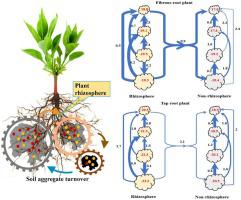当前位置:
X-MOL 学术
›
Agric. Ecosyst. Environ.
›
论文详情
Our official English website, www.x-mol.net, welcomes your
feedback! (Note: you will need to create a separate account there.)
Rhizosphere effects promote soil aggregate stability and associated organic carbon sequestration in rocky areas of desertification
Agriculture, Ecosystems & Environment ( IF 6.0 ) Pub Date : 2020-12-01 , DOI: 10.1016/j.agee.2020.107126 Junya Li , Xiaoliang Yuan , Le Ge , Qian Li , Zhiguo Li , Li Wang , Yi Liu
Agriculture, Ecosystems & Environment ( IF 6.0 ) Pub Date : 2020-12-01 , DOI: 10.1016/j.agee.2020.107126 Junya Li , Xiaoliang Yuan , Le Ge , Qian Li , Zhiguo Li , Li Wang , Yi Liu

|
Abstract Soil aggregate stability is an important index for predicting soil water loss and soil erosion resistance. Plant roots effectively control soil erosion and stabilize soil structure, which has a crucial influence on the formation of aggregates and soil organic carbon (SOC) sequestration. We examined how rhizosphere effects influence soil aggregate stability and its associated SOC contents and δ13C values, following a proposed extended model of carbon (C) flows between the aggregate size classes in the root systems based on 13C fractionation in each step of SOC formation. The results show that the rhizosphere effects significantly improved the stability of aggregates. The mean weight diameter (MWD) and geometric mean diameter (GMD) of rhizosphere soil aggregates were significantly higher than those of non-rhizosphere soil aggregates associated with plants with fibrous roots. SOC levels of all size aggregates in the rhizosphere soil of both fibrous and tap root plants were higher than those of non-rhizosphere soil. Moreover, SOC contents increased in the order of silt-clay particles (SCP, 1 mm). The δ13C values in non-rhizosphere soil were generally higher than those in rhizosphere soil in aggregates of the same size class, especially in the tap root plants. Except for the rhizosphere soil of fibrous root plants, the other three soil types (rhizosphere and non-rhizosphere soil of tap root plants, and non-rhizosphere soil of fibrous root plants) were shown to have aggregate δ13C values that decreased with increasing soil aggregate size. Δ13C enrichment of the SOC fractions showed that the general flow direction of SOC was from rhizosphere to non-rhizosphere, and from large aggregates to small aggregates. The C flow in the aggregates of rhizosphere soil was clearly greater than that in the non-rhizosphere soil, especially with the fibrous root plants. These findings suggest that plant roots have the potential to regulate soil structural stability, and enhance soil erosion resistance and SOC sequestration.
中文翻译:

根际效应促进了石漠化地区土壤团聚体的稳定性和相关的有机碳固存
摘要 土壤团聚体稳定性是预测土壤水分流失和土壤侵蚀抗力的重要指标。植物根系可有效控制土壤侵蚀,稳定土壤结构,这对团聚体的形成和土壤有机碳(SOC)固存具有至关重要的影响。我们研究了根际效应如何影响土壤团聚体稳定性及其相关的 SOC 含量和 δ13C 值,遵循基于 SOC 形成每个步骤中 13C 分馏的根系中团聚体尺寸类别之间碳 (C) 流动的拟议扩展模型。结果表明,根际效应显着提高了团聚体的稳定性。根际土壤团聚体的平均重量直径(MWD)和几何平均直径(GMD)显着高于与须根植物相关的非根际土壤团聚体。纤维和主根植物根际土壤中所有大小团聚体的SOC水平均高于非根际土壤。此外,SOC 含量以淤泥-粘土颗粒(SCP,1 mm)的顺序增加。非根际土壤中δ13C值在相同大小等级的团聚体中普遍高于根际土壤中,特别是在主根植物中。除须根植物的根际土壤外,其他三种土壤类型(主根植物的根际土壤和非根际土壤,和须根植物的非根际土壤)显示具有随着土壤团聚体尺寸增加而降低的团聚体 δ13C 值。SOC组分的Δ13C富集表明SOC的总体流动方向是从根际到非根际,从大聚集体到小聚集体。根际土壤团聚体中的 C 流量明显大于非根际土壤,尤其是须根植物。这些发现表明植物根系具有调节土壤结构稳定性、增强土壤侵蚀抗力和 SOC 封存的潜力。根际土壤团聚体中的 C 流量明显大于非根际土壤,尤其是须根植物。这些发现表明植物根系具有调节土壤结构稳定性、增强土壤侵蚀抗力和 SOC 封存的潜力。根际土壤团聚体中的 C 流量明显大于非根际土壤,尤其是须根植物。这些发现表明植物根系具有调节土壤结构稳定性、增强土壤侵蚀抗力和 SOC 封存的潜力。
更新日期:2020-12-01
中文翻译:

根际效应促进了石漠化地区土壤团聚体的稳定性和相关的有机碳固存
摘要 土壤团聚体稳定性是预测土壤水分流失和土壤侵蚀抗力的重要指标。植物根系可有效控制土壤侵蚀,稳定土壤结构,这对团聚体的形成和土壤有机碳(SOC)固存具有至关重要的影响。我们研究了根际效应如何影响土壤团聚体稳定性及其相关的 SOC 含量和 δ13C 值,遵循基于 SOC 形成每个步骤中 13C 分馏的根系中团聚体尺寸类别之间碳 (C) 流动的拟议扩展模型。结果表明,根际效应显着提高了团聚体的稳定性。根际土壤团聚体的平均重量直径(MWD)和几何平均直径(GMD)显着高于与须根植物相关的非根际土壤团聚体。纤维和主根植物根际土壤中所有大小团聚体的SOC水平均高于非根际土壤。此外,SOC 含量以淤泥-粘土颗粒(SCP,1 mm)的顺序增加。非根际土壤中δ13C值在相同大小等级的团聚体中普遍高于根际土壤中,特别是在主根植物中。除须根植物的根际土壤外,其他三种土壤类型(主根植物的根际土壤和非根际土壤,和须根植物的非根际土壤)显示具有随着土壤团聚体尺寸增加而降低的团聚体 δ13C 值。SOC组分的Δ13C富集表明SOC的总体流动方向是从根际到非根际,从大聚集体到小聚集体。根际土壤团聚体中的 C 流量明显大于非根际土壤,尤其是须根植物。这些发现表明植物根系具有调节土壤结构稳定性、增强土壤侵蚀抗力和 SOC 封存的潜力。根际土壤团聚体中的 C 流量明显大于非根际土壤,尤其是须根植物。这些发现表明植物根系具有调节土壤结构稳定性、增强土壤侵蚀抗力和 SOC 封存的潜力。根际土壤团聚体中的 C 流量明显大于非根际土壤,尤其是须根植物。这些发现表明植物根系具有调节土壤结构稳定性、增强土壤侵蚀抗力和 SOC 封存的潜力。











































 京公网安备 11010802027423号
京公网安备 11010802027423号